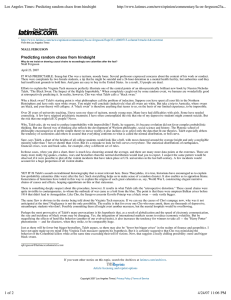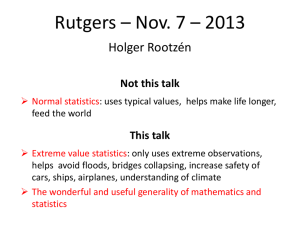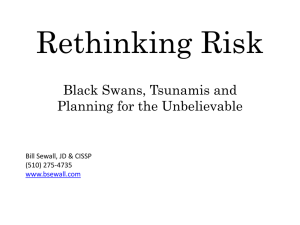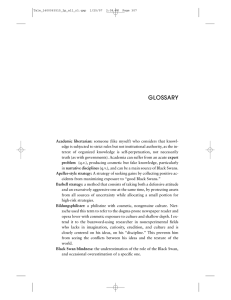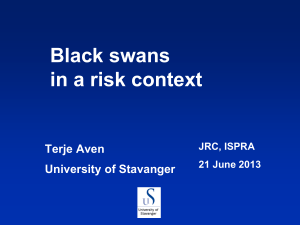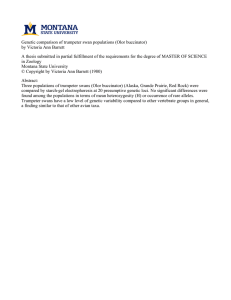Black Swans in Blue Suits
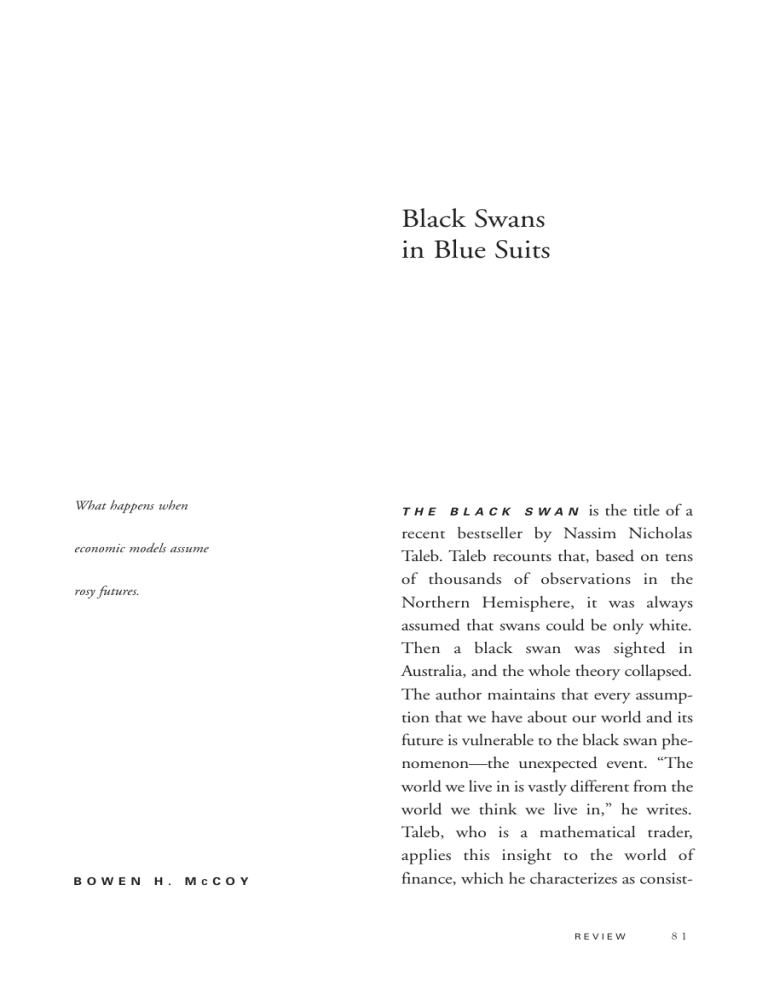
Black Swans in Blue Suits
What happens when economic models assume rosy futures.
B O W E N H .
M
C
C O Y
T H E B L A C K S W A N is the title of a recent bestseller by Nassim Nicholas
Taleb. Taleb recounts that, based on tens of thousands of observations in the
Northern Hemisphere, it was always assumed that swans could be only white.
Then a black swan was sighted in
Australia, and the whole theory collapsed.
The author maintains that every assumption that we have about our world and its future is vulnerable to the black swan phenomenon—the unexpected event. “The world we live in is vastly different from the world we think we live in,” he writes.
Taleb, who is a mathematical trader, applies this insight to the world of finance, which he characterizes as consist-
R E V I E W 8 1
ing of over-compensated men in blue suits living in a fantasy world in which the future can be controlled by sophisticated mathematical models and elaborate risk management systems.
In the context of the financial world, black swans, or extreme future events, are substantially underestimated because such events are not even imaginable until after they occur. Statistical modeling deals with events that are “known unknowns;” black swans are what Secretary of Defense
Donald Rumsfeld once called “unknown unknowns.” Similarly, we tend to be asymmetric in our perception of random events, attributing our successes to skill and our failures to external events beyond our control—that is, to random chance.
Taleb states that the U.S. economy is a mountain of risk and delusion, an interlocked world that we don’t really understand. Such a complex system does not allow for slack. In a normal economic system, smaller units go bankrupt regularly; however, in an interlocked complex system there is a clustering around the larger units. Banks become intertwined as a result of trading, derivatives and counter-party risks, so they may all go down together.
We have misused the bell curve of absolute probabilities, applying it to events that are unpredictable. All too common outlying events stretch out the bell-like symmetry of mathematical models, creating “long tails.” The standard probability bell curve is reasonably effective when there are large numbers of highly predictable outcomes, such as measurements of classroom grades of large numbers of students. But by basing our strategies for managing risk, including modern portfolio theory and the Black-Scholes formula for pricing options, on the normalized bell curve, we fail to take into account important events that occur so rarely that existing data points do not capture them.
Examples of such events include
September 11, 2001, the market crash of
October 1987, the failure of Long Term
Capital Management, and the virus caused by the recent sub-prime mortgage failures.
These rare black swan events have had powerful side effects, but were predictable only in hindsight.
Taleb cites several reasons why black swans are so troublesome. We have a tendency to seek examples that confirm our beliefs rather than contradict them—what might be called a confirmation bias. We have a weakness for making up compelling stories to explain events, what the author calls the narrative fallacy. We ignore silent evidence; that is, we fail to account for what we don’t actually see. In addition, we are willing to oversimplify and take nonrandom models too seriously (the ludic fallacy), and we have an ingrained habit of overestimating our knowledge and underestimating our ignorance (epistemic arro-
8 2 Z E L L / L U R I E R E A L E S T A T E C E N T E R
gance). As a result of these failings, we are predisposed to make snap decisions on the basis of minimal evidence and facile theories, preferring simple theories to messy reality. We see something on a printed page, on a computer screen, or in a
PowerPoint presentation, and allow the information to take on a life of its own. In the process, hypotheses and speculations lose their vagueness and abstraction and become concrete. We treat one thousand people repeating a single person’s view the same as one thousand people arriving at the same conclusion independently.
The risk management models in use today exclude the very events against which they claim to protect the businesses that employ them. They purport a layer of technical sophistication, the result of the simultaneous development of modern finance theory and information technology. Quantitative analysts have lulled the men in blue suits and their regulators (in somewhat cheaper blue suits) into an illusory sense of security.
The Black Swan was published prior to the sub-prime mortgage debacle, but that event neatly fits the model. Taleb discusses the fragile interlocking nature of globalization, which appears to be stable yet creates many potentially devastating black swans. He writes that we live under the threat of global collapse, as financial institutions have been merging into a smaller number of very large banks, and almost all banks are now interrelated.
This makes a financial crisis less likely, but when it does happen it is global, and it hits very hard. As Taleb writes, “Most traders are just ‘picking up pennies in front of a steamroller,’ exposing themselves to the high-impact rare event yet sleeping like babies, unaware of it.”
Perhaps I am confusing the narrative fallacy and epistemic ignorance, but I know that some market practitioners have worried for at least two years prior to
August 2007 about declining standards in the credit markets and lack of responsibility in the mortgage markets. If the smartest blue suits in the room saw this coming two years in advance, why did we not do something about it? Is Alan Greenspan correct in saying we can do nothing in a bubble
“until the fever breaks”?
All the economic incentives were lined up to keep the game going. Annual bonuses, performance appraisals, quarterly earnings reports and other measures of success were based upon continually originating more sub-prime mortgages, structured investment vehicles, collateralized debt obligations and the like. There were no black swans in the economic models.
What happened could be described as a systemic breakdown: a combination of fraudulent mortgage brokers and fraudulent borrowers, uninformed homebuyers, speculative buyers who owned as many as a dozen homes with no equity and an
R E V I E W 8 3
expectation of continually rising prices, overly aggressive Wall Street firms, overwhelmed rating agencies, and buyers of securitized mortgage debt who did not perform adequate due diligence. Cynicism ran rampant. Speculators in single-family residences never anticipated repaying their mortgages if things went wrong. Due diligence was forgotten in the rush to keep the markets boiling. Far too much emphasis was placed on Aaa ratings of paper as substitutes for doing homework.
As we have seen, trust is the key to global financial markets. When trust evaporates, which can happen overnight, financial firms can find it impossible to fund, and they fail. A principle cause of our current black swan is a basic principal/agency problem. Does a participant in the financial market system view the stakeholders to whom he is responsible as merely himself, his bonuses, his advancement, and his power within the firm, or does he consider a broader group of stakeholders that includes the owners of the firm?
Unfortunately, there have been too many free-riders who take no responsibility for their actions beyond their paychecks, as well as a dearth of true leadership (in both business and government) willing to take responsible actions to maintain trust in the system. It is classic case of short-term personal gain versus long-term societal gain.
The current crisis will take another couple of years to be resolved. Investment banks, in particular, must continue to raise new equity, diluting shareholders, while reducing leverage by at least onethird, further reducing return on equity.
New business models must evolve including lower returns on capital, lower compensation, more government regulation and a return to non-capital-intensive stable businesses such as wealth management. Most financial models will continue to ignore future black swans. If we model to the extreme event, we can no longer play the game, but if we do not model to the extreme event, we may be forced out of the game altogether.
8 4 Z E L L / L U R I E R E A L E S T A T E C E N T E R
